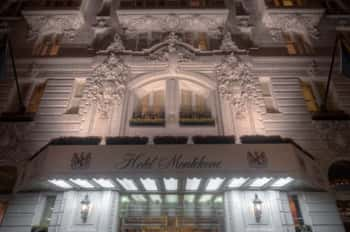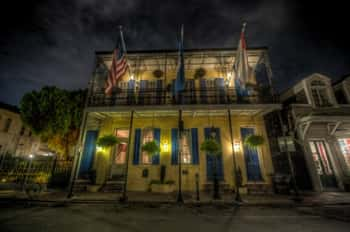141 Chartres St, New Orleans
The Jimani Bar was the site of a horrific mass murder. The unfortunate souls who died here may still roam around, seeking justice, or at least an answer.
If you read up on haunted locations in New Orleans, you’ll find plenty. Haunted mansions, restaurants with ghostly guests, and graveyards full of spectral residents dot this great southern city.
It breaks this writer’s heart to see that the Jimani Bar seems to slip under as many radars as it does. Locations of indescribable tragedies are hotbeds for paranormal activity. However, they can often be difficult to talk about due to the very nature of the incidents which made them infamous.
When a tragedy befalls a group of people who have historically been silenced and ignored by society, it must be talked about. What happened at this location in 1973 is remembered. The spirits haunting the Jimani Bar are heard heard.
Patrons of the Jimani bar often tell of whispers from nobody, inexplicable icy chills, and faint smells of burning hair and charred flesh. There are also reports of a full-bodied apparition on the second floor, where the UpStairs Lounge once served customers and doubled as a church congregation’s meeting place.
Owner Jimmy Massacci Jr. has a story about when he and a friend stopped by the bar. They both heard a sound despite the bar being closed. They investigated the sound and found that they had heard chains rattling in an old elevator shaft. Note: heavy elevator chains don’t just swing and rattle by themselves. Jimmy then felt what he described as ice cold air
, prompting both of them to exit as swiftly as they could.
There’s no doubt this location is haunted. Spirits of the past are hanging around here for a specific reason: they have a story to tell, and they don’t think it’s being told enough. What is the tragic story behind these tortured souls?
In 1973, The UpStairs Lounge was a gay bar located directly above the Jimini Bar. The location had also been used as a meeting place for the Metropolitan Community Church (MCC), which was the first gay church in the United States. Suffice it to say, the UpStairs Lounge was an important place for the gay community in New Orleans.
It was late June, and Pride Weekend was just wrapping up. The UpStairs Lounge celebrated the occasion by providing free beer and dinner to some 125 patrons. As the day was winding down and the beer ran out, that number began to dwindle, down to 60. Most were members of the MCC as well.
Just before 8 pm, a buzzer sounded in the UpStairs Lounge. Thinking a taxi had arrived, bartender Buddy Rasmussen asked Luther Boggs to answer the door. Opening it, Boggs only found fire and the smell of lighter fluid. Having a new source of oxygen, the blaze exploded into the lounge.
Rasmussen then led about 20 people out the unmarked exit door, while others tried their luck squeezing through the barred windows. Some escaped, but many did not. MCC Pastor Bill Larson tried but became trapped when the window fell on his torso. Stuck half in and half out the window, he burned to death, in full view of onlookers outside.
29 people died on-site, and 3 more succumbed to their injuries later. All told, 32 people were killed by an arsonist who would never be charged for their crime. Police suspected Roger Nunez, a Lounge regular with a history of mental health issues, but that lead dried up when he took his own life in 1974.
A significant part of the tragedy at the UpStairs Lounge was the reactions of the general public. Sentiments ranged from apathy to absolutely shameful remarks as this, I hope it burned their dresses off
. Some bodies remained unclaimed, their families too ashamed to admit to having a gay son. Police, government officials, and even the press just let the story fade away after a criminally brief investigation.
Radio hosts even got in on the action. They’d ask their listeners What will they bury the ashes of the queers in?
The punchline was fruit jars
. Remember folks, this wasn’t the 17th century. This was the 1970s. In New Orleans. The city that revels in being unique.
If there are spirits haunting the Jimani Bar, it’s because they feel forgotten and abandoned. The society which cast them out in life did the same to them in death.
Let it not be said that every member of the public was apathetic. James Massacci, the owner of the Jimini Bar at the time, put up his own money as a reward for the capture of the arsonist. According to his son Jimmy, nobody else put up any kind of reward.
Jimmy recounts My father was a very tolerant man
. Unlike many other citizens, Massacci saw gay people as just regular people and treated them the same way as anyone else. It upset him that the public and government officials just let the story of the tragedy fade away.
Over the years, paranormal investigators have probed the Jimani Bar for evidence of the supernatural. Many have taken EVP recordings, presumably the voices of those who perished here in 1973, still trying to be heard.
As with Jimmy Massacci’s story, large temperature variations have been felt on numerous occasions. Believe me, in the overwhelming heat and humidity of a Louisiana summer’s day, you’ll notice the icy touch that phantoms are believed to bring.
Ghost Hunters visited the Jimani Bar in 2012. They heard some strange noises and picked up some EVP, but couldn’t establish solid contact with any of the spirits.
The story behind the property at 141 Chartres Street prior to the UpStairs Lounge incident isn’t terribly colorful. Throughout the 19th and most of the 20th century, it was used as a storefront with offices or warehouses on the upper floors.
However, there is one rather peculiar story involving one of its early owners. Dr. Thomas Hunt, brother of U.S. congressman Theodore G. Hunt, purchased the property in 1849. Thomas was a very prominent doctor in the area and played a large role in the formation of the Medical College of Louisiana - which later became Tulane University.
In 1851, Thomas Hunt made headlines for something very unbecoming of his status in the medical community: murder.
At a Whig Party meeting, editor of the New Orleans Crescent John W. Frost gave a speech, presumably speaking with some vitriol against representative Theodore G. Hunt. Theodore would no doubt have felt slighted, to say the least, even to the point of requesting a gentleman’s duel with Frost.
That would’ve been a problem. In 1845, Louisiana legislators drafted a new state constitution. One provision of the new constitution declared that nobody who had ever taken part in a duel could hold public office (not to mention that dueling was illegal). Theodore, wanting to hold public office, couldn’t duel Mr. Frost.
Enter Dr. Thomas Hunt, who called Frost out as a liar. Frost held himself personally responsible
for any offense given to the Hunt family. Thomas, also holding him responsible, challenged Frost to a duel. Frost accepted. The men held their duel at a distance of forty paces, and Frost was killed.
The state brought a case against Dr. Thomas Hunt and others involved in the duel for the felony and killing
of John Frost. The Louisiana Grand Jury met and found Hunt responsible, however, one newspaper notes that nobody involved had been arrested and that it is supposed that they have left the State
.
When the time came for a trial in March of 1852, the judge assigned to the case excused himself and chose not to hear it. The secondary judge said he was too unwell to attend
, and a third judge said he didn’t have time to hear the case. The District Attorney felt he had done his duty but couldn’t try the case without a judge, and moved to dismiss.
Let’s be clear: John Frost accepted the duel proposed by Thomas Hunt. We can, as those at the time seemed to do, chalk this one up to the old adage play stupid games, win stupid prizes
. However, the fact remains that Hunt was found to be responsible for the felony killing of John Frost and was never held accountable because it seems people just didn’t care. Sound familiar?
Dr. Thomas Hunt carried on as the Dean of the University of Louisiana Medical Department for some time. He died in 1867, though the property at 141 Chartres stayed in the family for a few decades more. It’s curious that this property has ties to two stories of injustice by way of apathy.
You can find this late nite haunt
at 141 Chartres St, at the corner of Chartres and Iberville. Stop by for something from the grill, something from the tap, and maybe something from the spirit world.
Keep in your mind the souls of those who perished there, and don’t be surprised if they reach out to you.

New Orleans' most haunted Hotel

New Orleans' most Historic Hotel

The site of a deadly fire